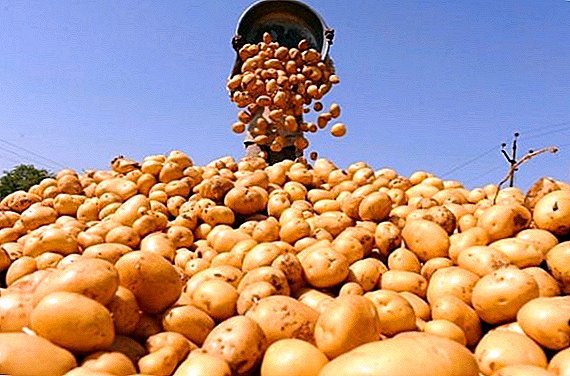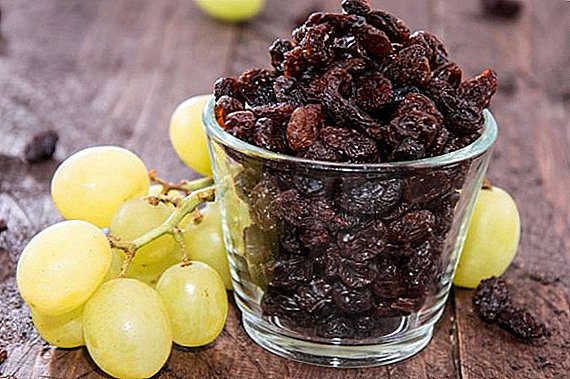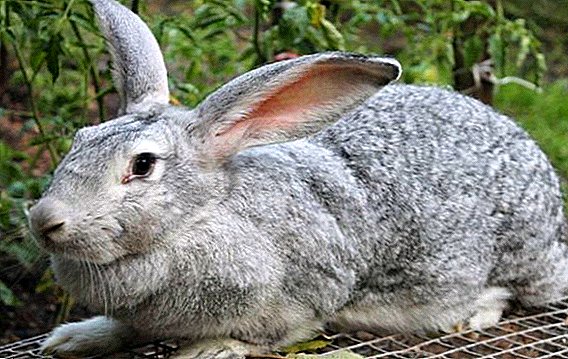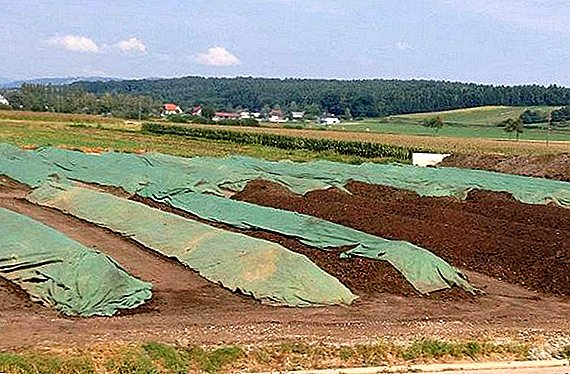 If the new crop has already ripened, but you do not have a basement for storing it, then a burt would be an ideal option - a shelter for vegetables, the construction of which does not require you to spend a lot of material expenses. Despite the fact that with such a system, potatoes, carrots and other horticultural products are stored directly on the ground (or in a small depression), even under a layer of straw, they can survive well until spring. How to organize the storage of potatoes in the colts and what exactly is the said shelter, we will tell below.
If the new crop has already ripened, but you do not have a basement for storing it, then a burt would be an ideal option - a shelter for vegetables, the construction of which does not require you to spend a lot of material expenses. Despite the fact that with such a system, potatoes, carrots and other horticultural products are stored directly on the ground (or in a small depression), even under a layer of straw, they can survive well until spring. How to organize the storage of potatoes in the colts and what exactly is the said shelter, we will tell below.
What is a collar
Among the simplest shelters that will help you preserve roots until next year are ditches, huts, pits and similar places, which can be arranged in any yard. The main requirement is to create them on high ground.to groundwater as deep as possible.
In this case, in addition to potatoes, almost all vegetables will remain safe and sound. As for the concrete collar in particular, in its simplest form it is a common mound of root crops located on the surface of the soil and hidden under a layer of straw, needles, tops, or other similar materials.
If we talk about a more complex structure, it provides for the installation of additional elements that provide adequate ventilation and an appropriate temperature regime.
Learn how to properly store carrots, tomatoes, onions, garlic, red cabbage, cucumbers, apples and corn.

The design and installation of shelter
The construction of any structure begins with the selection of the most suitable place for this place, and then you can proceed to all other works. We will talk about all the nuances and subtleties of the construction of the collar, from the preparatory work to the storage of vegetables and the requirements for this process.
Choosing a place
The harvest will be stored for a long time only if it will not be affected by external factors, and in the first place - high humidity. Therefore, before building a shelter for your vegetables, find on your site dry, windproof placewhere the groundwater level lies 0.5-1 m (or more) from the bottom of the future deepening.
It is good if it is located a little on an elevation, because in this way all the water that appears will be able to immediately flow down without stagnating. If this is not possible, then along the perimeter of the shelter it is imperative to organize a ditch (breaks out in a circle, retreating 0.5 m), into which rain and melt water will go, bypassing the store.
Important! Most often, the shoulders are placed in pairs, and between them are 4-5-meter walkways and 7-8-meter walkways.The parameters of the shelter being constructed, including not only the dimensions, but also the thickness of the covering layer, are selected taking into account the typical climate for your region residence and soil features.

For example, the width of the collar for potatoes directly depends on how cold the winter will be: the colder the wider. For the southern regions, indicators of 1–1.5 m are sufficient, for the middle lane the two-meter width of the shelter will be optimal, but in the conditions of Siberia it will be increased to three meters. In any case, it is important to consider the advice of local experienced organizations.
Did you know? "La Bonnotte" - the most expensive potato in the world, which is grown on the island of Noirmoutier and asking for a kilogram of root crops 500 euros. His popularity, he won an unusually delicate taste.
Ventilation
In any shelter, a good ventilation system is installed so that vegetables do not become rotten. In the case of the construction of clamps, the most popular options are supply and exhaust, supply and exhaust, pipe or active system.
The first - the most simple and provides for the flow of cold air flow through the channel located at the bottom with a cross section of 0.2 x 0.25 m, covered with wooden bars or grill.
It should have outlets outside the storage, but in such a way as to contain thawed and rainwater. If cabbage is placed in storage, then triangular pipes (0.4 x 0.4 m) are placed on the bottom of the pit to organize ventilation. As an alternative, you can use triangular boxes, knocked out of shields.
For large and rectangular shelters, a vertical hood in the form of additional wooden boxes is added to the ends of the prepared box. On the crest of the mound can be placed slats, shot down at right angles to each other. 
When organizing the exhaust ventilation cool air passes inside the collar, then, moving through the crop folded in it, heats up a little and approaches the ridge. Simply put, the comb is used in the air exchange, which remains covered only with straw to serious "minuses". Usually, a similar system is used when arranging a shelter (with an approximate width of 2-2.5 m) for storing potatoes and beets.
Pipe ventilation option provides for the installation of vertical pipes above the inlet duct or pipe located at the bottom of the collar. They are located at a distance of 3-4 meters from each other and from the ends. The height of the lattice parts of such additions (located at the bottom) varies between 1.2-1.5 m with gaps between the slats of 2-3 cm (in the case of potato laying) or 10 cm when storing cabbage and rutabaga.
At the top, all such pipes (vertically arranged) should not have gaps (it is made of tesa), and a gable hood is installed on top of the outlet structures, which will help protect the crop from rain and snow. 
Quite famous today is natural ventilation with ground cover insulation. With her presence, all storage costs are significantly reduced. Before storing the harvested crop, prepare a flat and rammed area of land, enclosed by a low soil bank.
Following this, an air distribution groove is created, and holes are drilled, with a depth of 1.5 times the thickness of the freezing layer. Between pipes of standard ventilation (located vertically) in an inclined position are installed lattice type pipes that do not extend outside (beyond the boundaries of the store).
They contribute to the transportation of heat to the folded vegetables and weatherization of the entire space inside the collar. When the outside air temperature decreases, the normal ventilation must be closed, and the heat at the depth (supplied from the holes) will diverge and flow to the crop using grid pipes installed with a slope.
Heating the surface of the shelter, the warm air flows into the ridge (not sealed with film material) and keep the temperature at a level not lower than 0 ° C, even if it is already below zero in the street.
Warm air flows bring moisture from the substrate to the vegetables, thereby protecting them from unnecessary water loss. With the arrival of spring or warming in the street, the intake and exhaust ventilation systems need to be opened. 
Temperature measurement
To preserve the harvest, it is worthwhile to think in advance about controlling the optimal temperature parameters inside the clutch. For this at a 30-degree angle they place thermometers in it: one in the middle of the shelter (along the ridge with a hollow of 0.3 m), and the second - from the northern part of 0.1 m from the base of the shelter.
Important! With the help of measuring devices you can always monitor the condition of vegetables and tubers, but when warming outside you will have to perform additional checks, opening the shoulders and taking a sample of the crop.In the autumn, the temperature indicators in the bursts are removed every day, and in the winter, two or three times in 7 days will be enough. Thermometers must be placed in one-piece cases, and after performing measurements, the holes in them are well covered with cotton, fabric or wooden plugs. Optimum temperature readings in such storage facilities depend on the type of products stored there. For example, for potatoes, this value is + 3 ... +5 ° C.

Shelter buildings
The quantity of the crop spoiled by spring in a collar directly depends on the type of covering material and its proper flooring. Such storage facilities can be covered with artificial heat-insulating materials, and can be hidden under alternating layers of straw and earth laid out in 2-4 tiers.
Having packed products, they are necessary immediately cover not with a thick layer of soil, the top line of which should rise above the masonry level, capturing its sides by 1-1.5 m (this way you can protect the masonry from flowing water).
The optimal layer thickness will depend on the traditional temperature in the winter season, the average rainfall, the location of the collar, the composition of the soil and other criteria: the type of stored crop, the amount of space for it and the depth of freezing of the substrate in the most severe frosts.

If you decide to replace one covering material with another, then be sure to consider the coefficient of thermal conductivity. For example, for a little wet straw flooring this value is 0.02, and for the soil - 0.08. This means that, using earth instead of straw, its layer should be 4 times thicker.
Important! When moistening any covering material (sawdust, straw or even soil), its coefficient of thermal conductivity will increase.In the area of the crest of the repository, the thickness of the shelter should be less than below, since the heat released from the product is directed upwards. If the covering layer is too thin, the vegetables at the bottom will start to freeze slightly, and if there are cracks in the crest and not a thick enough cover, any adverse conditions (strong wind or little snow) will cause the vegetables to freeze over the top of the embankment.
However, straw and earth shelter is a traditional option, which helps to better preserve the harvest, protecting it from damage. The upper part of the storage area is covered with straw before the start of severe frosts, and if a supply and exhaust ventilation system is also provided for in the collar, it is better to cover the ridge with earth or to cover it with additional straw. 
But before completely “sealing” the collar (this should be done before the start of severe frosts, when the temperature inside the storage facility drops to + 3 ... +4 ° C), the moist straw should be replaced with a dry one to avoid freezing of the crop.
Before strong frosts, you should also have time to spread straw around the shelter and increase the last layer of covering material. In the case when at the initial stage the straw layer was laid too thin, then some more material was added to it and only then all was covered with earth.
This solution will also be optimal when using last year’s straw, but it’s worth remembering that its do not immediately lay on the vegetables, because it can persist bacteria that serve as a source of disease. That is, woody leaves, old straw and dry tops from potatoes, slag, peat and other similar material are used only for subsequent layers of shelter.
Did you know? Residents of Belarus first place coniferous fir trees on the vegetables and root crops placed in the shoulders, which should scare off rodents and prevent rotting of the products on top, and gardeners from the Central regions immediately hide the shelter under straw and earth.
Storage features
Storage of the harvested crop begins with its placement there. In addition, it would be better if you pre-cool your crop in temporary clamps covered with earth and straw. Vegetables and potatoes are placed taking into account the angle of repose of the collar, and the flatness of the slopes can be checked using a building level or rail.
It is very important that the crop, which is put on storage, was free from signs of disease and pests. For potatoes it is a wet rot, black leg, fusarium and blight.
Cabbage and root vegetables should be placed 10-15 cm below the top of the pit, this is if you created a shoulder, starting with a small depression in the ground. As soon as the entire crop takes its place, we can assume that the process of its storage has already begun, which means that it is worth knowing about some of the features: systematic airing, temperature control and other important nuances.
Finishing the cover of the collar, you will certainly notice an increase in temperature indicators. Because of this, in the autumn time it is not necessary to close the intake and exhaust pipes, until there is a steady cold with a temperature of -3 ° C. A further decrease in temperature and cooling of stored vegetables to + 1 ... +2 ° C indicates the need for dense clogging of exhaust pipes with straw plugs.
As soon as the harvest temperature reaches + 4 ... +5 ° С, they open again. Exceeding the values of + 7 ... +8 ° C indicates the need for snow removal, for which several holes are made in the side parts of the ground cover and ridge. At night, they can be clogged with sawdust or even snow, again opening in the daytime.
If, in spite of all your actions, the temperature in the shelter does not want to fall, and moisture and evaporation are already visible outside, then will have to open the vault in these places, so that you can inspect the vegetables and after a little cooling of the crop again cover. Having taken shelter, you can also retrieve the contents of the vault in order to implement or move to another location.
Important! When unloading shoulders in cold weather, it is necessary to use portable "mini-greenhouses" made of blankets or tarpaulin.If you notice that the temperature of the potatoes dropped to +1 ° C, the cabbage turned cold to +2 ° C, and the roots to +1 ° C, then storage must additionally insulate with sawdust and snow.
When self-construction of the collar, you probably know what it is and what the shelter is built specifically in your case. If there is a good ventilation system organized in it, the ventilation can be carried out only a few times during the winter, but if the air supply to the crop is insufficient, it will have to be periodically ventilated in full or in part.
If in the latter case there are fewer requirements for this process, then full airing should be carried out only in dry and cool weather, and when permanent frosts appear to -3 ... -4 ° C, even supply ventilation pipes should be closed with straw. 
As soon as it is warm enough outside and the temperature inside the pile rises even more, the ground cover can also be removed, first from the ridge, and later from the whole cover. The removed soil is perfect for backfilling trenches for draining water.
As you can see, harvesting the harvested crop is an easy task, but in order for vegetables and root crops to be well preserved, it is much more important to monitor the temperature and humidity inside the shelter.












